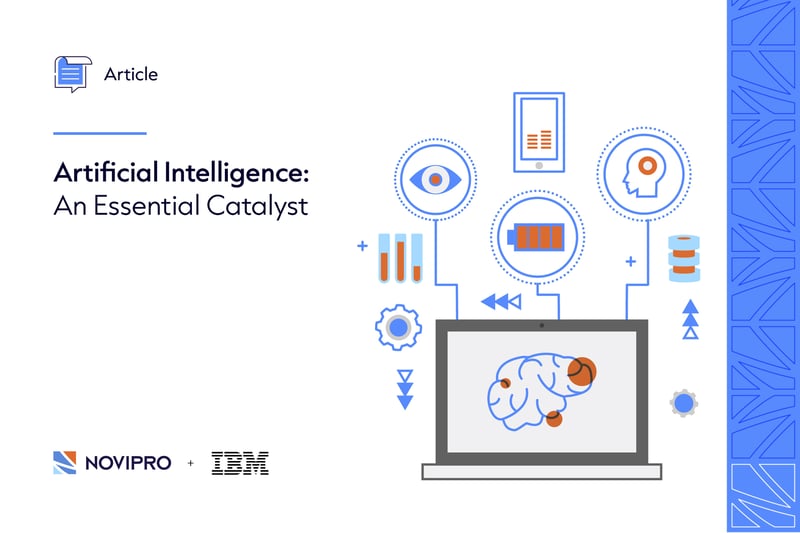The annual study by NOVIPRO Group and Léger, IT Trends, reveals that over half of companies are investing in AI in some capacity. Yet, a critical question arises: do they invest in tools that align with their specific reality? The real challenge lies in understanding how this technology can address the specific needs of an organization, whether it’s for automation, predictive analytics, content generation, or strategic decision-making.
For more detailed statistics and in-depth insights on artificial intelligence, download IT Trends now!
Let’s take a moment to reflect on these organizational needs and explore where AI can truly make a difference:
Why Has AI Become a Strategic Priority for Businesses?
Artificial intelligence has emerged as one of the most sought-after priorities for businesses, seen as a hallmark of innovation and competitiveness. Today, many organizations are racing to invest in AI, driven by the belief that it is essential to staying ahead. However, the key question is not merely “Why invest in AI?” but rather, “How can we ensure that AI genuinely addresses a strategic need?”
Despite widespread enthusiasm, many business encounter difficulties in defining a precise application of AI that aligns with their specific objectives. In the absence of adequate structures or the necessary internal expertise, they occasionally adopt solutions that do not correspond to their actual needs, thereby limiting the effectiveness and scope of their AI initiatives. Consequently, investments struggle to yield concrete results, and projects remain confined to experimental stages. Michael Bélanger, Advisory Technical Specialist at IBM Canada, states: "Too often, companies rush into AI projects without evaluating the organizational implications. Successful integration begins with a comprehensive understanding of needs and a clear strategy."
Advanced technologies, such as generative AI or predictive analytics, should not be viewed as universal solutions but rather as tools tailored to address specific, well-defined challenges and integrated in a coherent manner into the overall strategic framework.
In essence, AI adoption cannot be reduced to a mere technological initiative. It requires assessing whether the organization has the necessary maturity to integrate these solutions effectively and achieve a tangible return on investment.
To learn more about the fundamentals of artificial intelligence and how it can align with your strategy, visit our blog.
Learn more about the origins of artificial intelligence
Investing in AI: Bridging the Gap Between Ambition and Reality
For many businesses, artificial intelligence appears to be a necessary step toward innovation. Yet, initial enthusiasm often fails to translate into tangible results. Driven by the need for rapid transformation and fear of being outpaced by competitors, companies make significant AI investments without always laying the groundwork for successful integration.
Projects frequently stall at the pilot stage due to a lack of qualified personnel, unprepared data, or a clear implementation strategy. This lack of preparation leads to stagnant investments and unattainable expectations. To turn AI into a genuine driver of performance, organizations must accurately assess their needs, train their teams, and adapt existing systems to integrate these technologies smoothly and productively.
Is your company truly leveraging the full potential of AI?
1. Intelligent Automation: Simplifying for Greater Performance
Intelligent automation is no longer limited to repetitive tasks; it is redefining how complex processes are managed, enabling systems to collaborate seamlessly and allowing teams to focus on high-value activities. It addresses the intricacies of business operations, orchestrating data management and optimizing workflows in real time.
For example, in the financial sector, some companies have adopted intelligent automation solutions to continuously handle regulatory compliance. Reports are generated, reviewed, and submitted to authorities in minutes, freeing teams to focus on more strategic tasks. Intelligent automation is no longer just about productivity; it’s about agility, error reduction, and smarter resource allocation.
The challenge for organizations is not only to deploy this technology but to ensure it aligns with critical processes to maximize its impact.
2. Generative AI: Personalized Innovation
Generative AI unlocks new possibilities for large-scale personalization, creating unique interactions tailored to customer preferences. Consider an e-commerce platform: with generative AI, it can dynamically generate product descriptions and adapt recommendations in real time based on user behavior. The result? A significant increase in conversions and stronger customer loyalty.
This technology is also revolutionizing product development. Research and development (R&D) teams can use generative AI to design prototypes faster and more cost-effectively. Far from being just a marketing tool, generative AI reimagines the customer experience while making innovation processes more agile and efficient.
3. Predictive Analytics: Seeing Beyond the Data
Predictive analytics has become an indispensable tool for businesses aiming to anticipate risks and seize opportunities in real time. By analyzing historical data and leveraging machine learning models, it can forecast customer behavior, demand fluctuations, and equipment failures.
In logistics, for instance, predictive analytics optimizes fleet management by identifying potential breakdowns and adjusting routes based on traffic forecasts. This enables companies to reduce maintenance costs and improve delivery punctuality. Predictive analytics transforms raw data into actionable insights, empowering organizations to act proactively rather than merely reacting to events.
4. Decision Intelligence: Smarter, Faster Choices
Decision intelligence is redefining how businesses make strategic choices. Unlike traditional analytics, which simply provide data, decision intelligence delivers optimal solutions in real time and adapts to changing contexts.
For example, a supermarket chain used this technology to adjust inventory management based on sales trends, weather conditions, and local events. This approach not only reduced waste and stockouts but also enhanced customer satisfaction through improved product availability.
Decision intelligence does more than speed up decision-making—it enhances accuracy and relevance, enabling organizations to make more informed, market-driven strategic choices.
Conclusion
Artificial intelligence should not be viewed merely as a technological trend but as a strategic opportunity for transformation. Its adoption requires in-depth reflection on organizational maturity, the definition of needs, and alignment with business objectives. Companies that successfully integrate AI strategically will be better positioned to address market challenges and seize opportunities.
However, transitioning from ambition to execution requires selecting the right tools and implementing an appropriate strategy. If your organization is seeking to automate processes, analyze complex data, or develop advanced artificial intelligence models, platforms such as IBM watsonx provide solutions specifically designed to meet these challenges.








